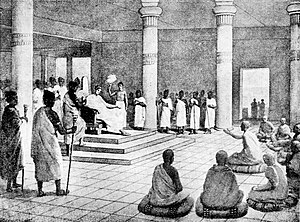Nāgasena
Nāgasena (T. klu sde ཀླུ་སྡེ་; C. naxian biqiu/naqiexina 那先比丘/那伽犀那) was a scholar-monk from the Sarvastivada tradition who famously engaged in a debate with Indo-Greek king Milinda as recorded in the Milindapañha of the Pali tradition and the Sanskrit Nāgasenabhiksusūtra.[1]
In his dialog with King Milinda, Nāgasena used the simile of the chariot to explain the Buddhist concept of the not-self (anatman). Just as the chariot is not one singular independent thing, but it is composed of parts, in the same way, that which we call the "self" (atman) is not a singular independent entity, but it is likewise composed of parts. Just as the chariot comes into being based on mulitple causes and conditions, so does the "self."
According to the Milindapañha, Nagasena studied under the Greek Buddhist monk Dharmarakṣita near Pātaliputta (modern Patna). He also became an arhat under his guidance.
Notes
- ↑ Buswell & Lopez 2014, s.v. Nāgasena.
Sources
 Buswell, Robert E.; Lopez, Donald S. (2014), The Princeton Dictionary of Buddhism, Princeton University
Buswell, Robert E.; Lopez, Donald S. (2014), The Princeton Dictionary of Buddhism, Princeton University- Jestice, Phyllis G (2004). Holy People of the World: A Cross-cultural Encyclopedia. ABC-CLIO. ISBN 978-1-57607-355-1.
- Xing, Guang (1 January 2005). The Concept of the Buddha: Its Evolution from Early Buddhism to the Trikāya Theory. Psychology Press. ISBN 978-0-415-33344-3.
